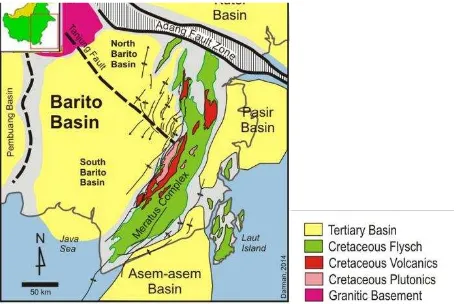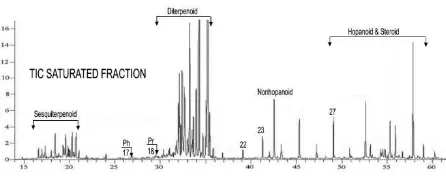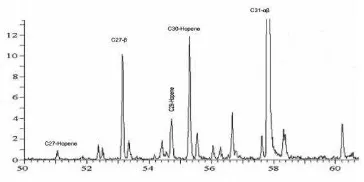The Liburdinding Miocene Pamaluan Coal Mine, Pasir-Sub Basin,
East Kalimantan:
Origin and palaeoenvironmental implications
from biomarker studies
A.H. Hamdani 1,
1University of Padjadjaran, Jl. Raya Bandung-Sumedang Km.21, 10560, Jatinangor, Indonesia
Email: [email protected]
Abstract
The coals from the Liburdinding coal mine in Paser regency, Pasir Sub-Basin, East Kalimantan, Indonesia were inves-tigated with respect to organic geochemistry to determine their origin and to reconstruction the depositional environment. For this purpose, biomarker analyses have been done. The distribution of saturated and aromatic hydrocarbons of or-ganic matter in a series of Miocene Pamaluan coal formation were identified. The rank of the Pamaluan coals ranged from sub-bituminous to bituminous coals (0.46–0.55% Ro), based on measurements of huminite/vitrinite reflectance. The predominance of diterpenoids in both the saturated and aromatic fractions indicated that the main sources of organic matter were gymnosperms (conifers). The presence of hopanoid biomarkers indicates the contribution of prokaryotic organisms, such as bacteria and fungi, whereas the identification of non-hopanoid triterpenoids implies a contribution of angiosperms to the coal organic matter. The variations in compositions of biomarkers indicate changes in the water level, due to seasonal drying of the mire, which caused vegetation differences in the palaeoplant communities and changes in the dysaerobic onditions during peatification.
Key word: Miocene, Pamaluan, coal, Sub-Pasir basin, biomarker. .
Introduction
In the past few decades, molecular organic geo-chemistry has played an important role in the explo-ration of coals and fossil fuels generally. It involves the analysis of the soluble organic matter and identi-fication of organic compounds with hydrocarbon skeletons related to biological molecules present in the tissues of living organisms (K. E. Peters, C.C. Walters, J. M. Moldowan,2005; MacKenzie, A.S., Patience, R.L., Maxwell, J.R., 1981). These bi-omarkers allow for the recognition of the main input of organic matter (OM), identification of coal ma-turity, an indicator of the palaeoenvironment in which they were deposited.
Although the coal deposits are widespread in Pasir Regency, organic geochemical data are limited. The determine of origin and paleoenvironmental of
coal in Liburdinding Coal Mine are the objective of this study.
Geological Setting
Figure 1.Liburdinding coal mine location, Paser Re-gency, East Kalimantan.
The basin is defined by the Meratus Ophiolitic Complex to the west and separated from the Kutei Basin to the north by a flexure related to the Adang Fault. The basin has a narrow opening to the south towards the Asem-Asem basin. The Barito Basin is an asymmetric basin, forming a foredeep in the east-ern part and a platform approaching the Meratus Mountains towards the west (Fig. 2).
Figure 2. A geological summary map of Pasir Basin (Darman H., 2014)
The Pasir Basin commenced its development in the Late Cretaceous, following a micro-continental collision between the Paternoster and SW Borneo mi-crocontinents. Early Tertiary extensional defor-mation occurred as a tectonic consequence of that
oblique convergence. In Liburdinding Coal Mine, the Late Cretaceous uplifted caused displacement of Haruyan Formation which contains of ultrabasic rocks which were then intruded by granite, granodio-rite and diogranodio-rite; a NE-SW horst-graben structural was developed and became accomodation space for lacus-trine sediment of the Tanjung and Pamaluan For-mations. The Pasir Basin is underlain by Jurassic Cretaceous ultrabasic rocks and the Jurassic Pitap Formation. These are overlain by the Tanjung, Berai, Pamaluan, and covered by Quaternary alluvium. Re-search indicates that coal is formed mainly in the Tanjung, Pamaluan Formations within the basins. A generalised stratigraphic column is shown in Figure 3.
Figure 3. Geological Map and general stratigraphic column in Liburdinding and surrounding area.
The Pamaluan Formation consists of quartz sandstone intercalation with claystone, shale, lime-stone and siltlime-stone, well bedded quartz Sandlime-stone is the major constituent of rock, blackish grey to brown-ish, fine to medium grained, well sorted, sub-rounded to rounded, compact, carbonaceous or calcareous. Locally, contains cross bedded and parallel lami-nated. Thickness of layer between 1 -2 m. Claystone, thickness 45 cm in average. Shale, brownish grey to dark grey, compact, thickness of layers about 10 – 20 cm. Grey Limestone, massive, medium – coarse grained, locally bedded, contains of large foraminif-era. Siltstone, blackish to dark grey is no blank line between sections and continue as shown.
Experimental
phase into liquid. This concentrate liquids then fil-tered by HPLC process to separate fractions includ-ing saturated, aromatic, NSO, and asphaltenes. Fur-thermore, saturated and aromatics fractions were tested in GC instrument so that the chromatograph pattern could be identified. The GC instrument that used in this research is Varian Series 3400 Gas Chro-matograph under standard conditions with T0 = 70⁰C, hold time I = 2 min, Rate I = 8⁰C/min, Tf I = 280⁰C, hold time II = 45 min, Rate II = 10⁰C/min, Tf II = 300⁰C, hold time III = 10 min.
The saturated and aromatics fractions were pre-pared in Mole Sieve Analysis for GCMS test on the next stage. The specific biomarkers were investigated from saturated and aromatics fractions through GC/MS method. The GC/MS instruments used in this experiment is Shimadzu GCMS-QP2010 with Shi-madzu GC-2010 in standard conditions with T0 = 120⁰C, hold time I = 2 min, Rate I = 5⁰C/min, Tf I = 200⁰C, hold time II = 0.5 min, Rate II = 5⁰C/min, Tf II = 300⁰C, hold time III = 30 min. These GCMS standard conditions are slightly different with usual GCMS experiment, the base temperature is lower than usual to make it more effective for biomarker appearance.
Identification of individual compounds was ac-complishedbased on retention time in the total ion current (TIC) chromatogram and comparison of the mass spectra with published data. All the biomarkers were identified from GC and GCMS instrument us-ing GCMS Postrum Analysis with several libraries BENZODIAZEPINE, PESTEI_3, NIST 08, WILEY and R. P. Philp (1985). The peak areas from the gas chromatograms in relation to that of internal stand-ards were used to calculated the relative percentages and absolute concentrations of different compound groups in the saturated and aromatic hydrocarbon fractions.
Results and discussion
Bulk Geochemistry Parameters
The normalized yields of the soluble organic matter (SOM) are listed in Table 1 together with the
relative proportions of saturated and aromatic hydro-carbons, NSO compounds and asphaltenes of the SOM.
Table 1.Bulk organic geochemical of EOM & n-alkane No. Sat. Aro. NSO Asph. CPI Pr/Ph
PM-4 17 3 12 68 3.1 0.9
PM-8 12 7 14 76 3.6 1,2
PM-18 26 5 25 44 4.1 1.4
PM-21 15 9 20 56 5.9 1.7
From the Table 1; the EOM yield vary between 11.5 and 38.2 mg/g C org . The average proportion of hydrocarbons (saturate and aromatic fractions) 23% (with min 19% and max 31%), it is supported that the coal were immature to early mature stage (0.46– 0.55% Ro; with average Ro = 0.48%). The NSO and asphaltenes were dominated in the EOM (more than 50%).
n-Alkanes, isoprenoids
The n-alkane patterns are dominated by long-chain n-alkanes with a marked odd-over-even pre-dominance and maximum intensities in the n-C27 to n-C31 range. The high values of the carbon preference index (CPI = 3.1 to 5.9, according to Bray and Evans, 19613) are consistent with the classification of the coals as subbituminous B (Tissot and Welte, 1984). The relative proportions of mid-chain (nC21–25) and long-chain (n-C27– 31) n-alkanes relative to the sum of n-alkanes show minor variations with depth and illustrate the predominance of n-alkanes of high mo-lecular weight.
Figure 4. TIC chromatogram saturated fraction of Pamaluan coal sample
source for coal (Eglinton and Hamilton, 1967). The n-al-kanes of low molecular weight (<C25) were small amount
identified in coal samples (9% to 29% of the total n-alkane concentrations). This condition was explained that the al-gae and microorganism were predominantly as an OM source to coals (Cranwell, 1977). The mid-chain n-alkanes were dominantly in the lower seam comparing to the upper coal seam; indicated that the algae and microorganism were influence more bigger in the upper coal seams.
Mostly of the coals are pristane/phytane ratios (Pr/Ph) above 1.0 (Figure 4 which interpreted that coal was deposited under dysaerobic conditions.
Sesquiterpenoids, diterpenoids, nonhopaoid and triterpe-noids
In the saturated fraction (Figure 4) of coal sam-ples were identified the cadalane and drimane type in small amount. Also detected in the saturated hydrocarbons a pimarane, abietane, and C19 to C20 range
phyllocladane-type diterpenoids. The tetra- and pentacyclic triterpenoids of the oleanane (olean-12-ene, olean-13(18)-ene), ursane (urs-12-ene) and lupine (des-A-lupane) type have been described.
The sesquiterpenoid type of cadalene (H) and re-tene was found significantly in aromatic fraction of coal samples (Figure 5). Abietene-type was also detected in this fraction. In addition, The monoaromatic pentacyclic triterpenoids identified as 24,25-dinoroleana-1,3,5(10),12-tetraene, 24,25-dinorursa-1,3,5(10),12-tetraene, and 24,25- dinorlupa-1,3,5(10)-triene have been identified.
Figure 5. TIC chromatogram aromatic fraction of Pamaluan coal sample
Hopanoids
The hopanoids are abundant in the Pamaluan coals. The hopane composition in all samples which have identify on m/z 191 (Figure. 6) is characterized by the presence ββ- and αβ-type hopanes from C27 to C31, with an exception of C28 homologues. The C30 17(21)-hopane is the most abundant hopanoid in the saturated fraction of the coals samples. The abun-dance of hopanoids suggested that there were direct bacterial contribution of this compound (Ourisson, et al., 1979; Wakeham, 1990; Volkman, 1976).
Figure 6. Mass fragmentogram of m/z 191 of coal sample from Pamaluan Formation
Conclusion
The depositional condition and origin of Pamaluan coal of Oligo – Miocene from the Pasir Ba-sin, in Liburdinding Coal Mine site, have been eval-uated using coal organic geochemistry.
The composition of the geochemical fossils were shown that the peat-forming vegetation domi-nated by gymnosperm plants, followed by prokary-otic organisms and angiosperms. The plant precur-sors of Pamaluan dominated from gymnosperm fami-lies Podocarpaceae, Cupressaceae, Pinaceae and Taxodiaceae
Based on higher pristane/phytane ratios of
the Pamaluan coals, interpreted as indicating dysaerobic to aerobic conditions in this part of the mire.
Acknowledgments
Samples and a geological information were kindly given by the PT. Selatan Selabara.
References
Brassell, S.C., Comet, P.A., Eglinton, G., Isaacson, P.J., McEvoy, J., Maxwell, J.R., Thompson, I.D., Tibbetts, P.J.C., Volkman, J.K.. The origin and fate of lipids in the Japan Trench. In: Douglas, A.G., Maxwell, J.R. (Eds.), Ad-vances in Organic Geochemistry. Pergamon Press, Oxford, 1989, pp. 375–392.
Darman H., A geological summary map of Barito Basin and Meratus Complex, 2014
de Leeuw J. W. and Baas M. (1986) Early-stage diagenesis of steroids. In Biological Markers in the Sedimentary Record (Edited by Johns R. B.), 1986, pp. 101-124. Elsevier, Am-sterdam.
Gagosian R. B., S. O., Smith and G. E., Nigrelli, Vertcal transport of steroid alcohols and ketones measured in sediments trap experiments in the Equatorial Atlantic Ocean, Geochim. Cosmochim. Acta, 1982, 46, 1163-1172.
K. E. Peters, C.C. Walters, J. M. Moldowan, The Biomarker Guide, Vol. 2: Biomarkersand Isotopes in the Petroleum Ex-ploration and Earth History, Cambridge University Press, Cambridge, UK, 2005, p. 483–486, 499–500
MacKenzie, A.S., Patience, R.L., Maxwell, J.R., Molecular changes and the maturation of sedimentary organic matter. In: Atkinson, G., Zuckermann, J.J. (Eds.), Proc. 3rd Annu. Karcher Symp. Origin and Chemistry of Petroleum. Per-gamon, Oxford, 1981, pp. 1 – 31.
Nishimura M., 5fl-isomers of stanols and stanones as potential markers of sedimentary organic quality and depositional paleoenvironments. Geochim. Cosmochim. Acta 1982, 46, 423-432.
Ourisson, G., Albrecht, P., Rohmer, M., The hopanoids paleo-chemistry and paleobiopaleo-chemistry of a group of natural prod-ucts. Pure Appl. Chem. 1979, 51, 709–729
R. P. Philp, Fossil Fuel Biomarkers. Applications and Spectra.
Elsevier, Amsterdam,The Nederlands, 1985, pp. 12–33, 188, 259
Simoneit, B.R.T., Grimalt, J.O., Wang, T.G., Cox, R.E., Hatcher, P.G., Nissenbaum, A., Cyclic terpenoids of contemporary resinous plant detritus and of fossil woods, amber and coal. Org. Geochem. 10, 1986, 877–889
Tissot, B.T., Welte, D.H., Petroleum Formation and Occurrences, 2nd ed. Springer, Berlin. 1984, 699 pp.
Volkman, J.K., Allen, D.I., Stevenson, P.L., Burton, H.R., 1986. Bacterial and algal hydrocarbons from a saline Antarctic lake. Ace Lake. Org. Geochem. 10,, 1986, 671–681. Wakeham, S.G., Algal and bacterial hydrocarbons in particulate


